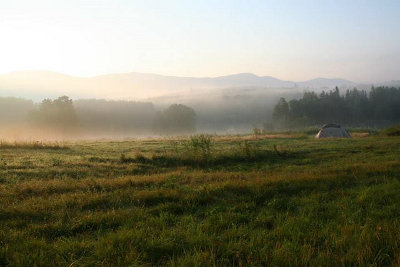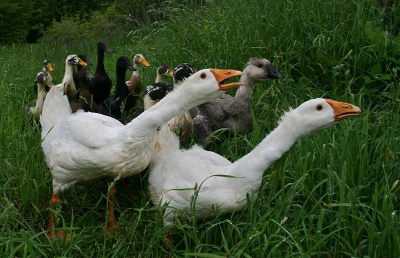
Turning old fields back into pastures
 When
Ben Falk first moved to his farm, much of it was pasture, but he felt
it was "crazy to use fossil fuel to mow down the field every year, and I
let it go." At the time, he believed that allowing succession to
take place in the field (with grasses giving way to taller herbs and
finally woody plants) was the best way to heal his troubled soil.
However, when he finally got ready to add animals to his farm, Falk
discovered that neglect had been a severe mistake since "abandoned
poor-soil fields have a stubborn inertia." In other words,
reclaiming the grass was a tough process.
When
Ben Falk first moved to his farm, much of it was pasture, but he felt
it was "crazy to use fossil fuel to mow down the field every year, and I
let it go." At the time, he believed that allowing succession to
take place in the field (with grasses giving way to taller herbs and
finally woody plants) was the best way to heal his troubled soil.
However, when he finally got ready to add animals to his farm, Falk
discovered that neglect had been a severe mistake since "abandoned
poor-soil fields have a stubborn inertia." In other words,
reclaiming the grass was a tough process.
Falk's first impulse was
to scythe the old fields in hopes of returning them to quality pasture,
but he soon discovered that mowing and scything don't have the same
effect. While mowing patchy fields increases stem density of
grasses (filling in the gaps), scything actually tends to retard grass
growth unless you cut the ground very often. Infrequent scything
drops tall stems to the ground, where they form a mulch on the surface
and shade out new growth.
 Next,
Falk figured grazing might do the trick. Unfortunately, grazing a
poor pasture with no mechanical cutting stage afterwards just selects
for the plants your livestock don't like, so his pastures weren't
getting any better. However, once Falk began grazing, then coming
behind the animals to mow and spread grass seeds, his pastures began to
provide more food for his sheep and poultry. Recently, he's also
been experimenting with burning as a way of jump-starting this process.
Next,
Falk figured grazing might do the trick. Unfortunately, grazing a
poor pasture with no mechanical cutting stage afterwards just selects
for the plants your livestock don't like, so his pastures weren't
getting any better. However, once Falk began grazing, then coming
behind the animals to mow and spread grass seeds, his pastures began to
provide more food for his sheep and poultry. Recently, he's also
been experimenting with burning as a way of jump-starting this process.
All of this isn't to say
that Falk is no longer a fan of scything. He's found that once
burning, grazing, seeding, and mowing have set back succession, he's
able to keep the pastures in check with grazing followed by
scything. Just like with his earth-moving,
Falk believes that it's worthwhile to use fossil fuels during the early
stages of reclaiming his land, but hopes to move away from machinery as
his farm improves.
| This post is part of our The Resilient Farm and Homestead lunchtime series.
Read all of the entries: |
Want more in-depth information? Browse through our books.
Or explore more posts by date or by subject.
About us: Anna Hess and Mark Hamilton spent over a decade living self-sufficiently in the mountains of Virginia before moving north to start over from scratch in the foothills of Ohio. They've experimented with permaculture, no-till gardening, trailersteading, home-based microbusinesses and much more, writing about their adventures in both blogs and books.
Want to be notified when new comments are posted on this page? Click on the RSS button after you add a comment to subscribe to the comment feed, or simply check the box beside "email replies to me" while writing your comment.
- Remove comment
